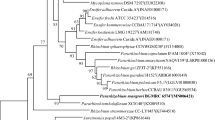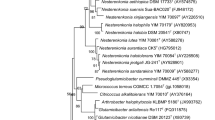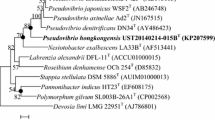Abstract
A Gram stain-negative, coccoid rod-shaped, motile by gliding, facultatively aerobic bacterium, designated W5, was isolated from Caenorhabditis elegans samples in Baotianman Natural Reserve (33° 27′ 47′′ N; 111° 48′ 32′′ E), Nanyang, China. The isolate was characterized taxonomically using a polyphasic approach. The 16S rRNA gene of strain W5 exhibited 98.1–99.7% similarity to the 16S rRNA genes of members of the genus Stenotrophomonas, and < 98.0% similarities to those of other bacterial species in the family Lysobacteraceae. The most closely related strains were Stenotrophomonas rhizophila JCM 13333T (99.7%) and Stenotrophomonas bentonitica DSM 103927T (99.2%). The predominant respiratory quinone of the isolate is Q-8. The major fatty acids are iso-C15:0 (38.2%) and antesio-C15:0 (16.6%). The draft genome of strain W5 had a length of 4,402,751 bp and a DNA G + C content of 67.3 mol%. The ANI values between the draft genomes of strain W5 and its closest phylogenetic neighbors S. rhizophila JCM 1333T and S. bentonitica DSM 103927T were 84.7% and 85.0%, respectively. The DDH value between W5 and S. rhizophila JCM 13333T was 30.8%, which was the highest DDH level. We propose that strain W5 represents a novel bacterial species with the name Stenotrophomonas nematodicola sp. nov. and W5 as the type strain. The type strain is W5 (= CPCC 101271T = CGMCC 19401T = KCTC 82903T).

Similar content being viewed by others
Availability of data and materials
The DDBJ/EMBL/GenBank accession number for the 16S rRNA gene sequence of strain CPCC 101271T is MT126327; The draft genome sequence of strain CPCC 101271T is WIAY00000000.
Change history
07 February 2022
A Correction to this paper has been published: https://doi.org/10.1007/s00203-021-02751-3
References
Alavi P, Starcher MR, Zachow C, Müller H, Berg G (2013) Root-microbe systems: the effect and mode of interaction of Stress Protecting Agent (SPA) Stenotrophomonas rhizophila DSM14405(T.). Front Plant Sci 4:141
Brooke JS (2012) Stenotrophomonas maltophilia: an emerging global opportunistic pathogen. Clin Microbiol Rev 25:2–41
Collins MD, Pirouz T, Goodfellow M, Minnikin DE (1997) Distribution of menaquinones in actinomycetes and corynebacteria. J Gen Microbiol 100:221–230
Felsenstein J (1981) Evolutionary trees from DNA sequences: a maximum likelihood approach. J Mol Evol 17:368–376
Felsenstein J (1985) Confidence limits on phylogenies: an approach using the bootstrap. Evolution 39:783–791
Garrity G, Holt J (2001) The road map to the manual. In: Boone DR, Castenholz RW, Garrity GM (eds) Bergey’s manual of systematic bacteriology, vol 1, 2nd edn. The Archaea and the deeply branching and phototrophic Bacteria. Springer-Verlag, New York, pp 119–166
Gray NF (1984) Ecology of nematophagous fungi: comparison of the soil sprinkling method with the Baerman funnel technique in the isolation of endoparasites. Soil Biol Biochem 16:81–83
Huang XW, Niu QH, Zhou W, Zhang KQ (2005) Bacillus nematocida sp. nov., a novel bacterial strain with nematotoxic activity isolated from soil in Yunnan, China. Syst Appl Microbiol 28:323–327
Kim Y, Mylonakis E (2012) Caenorhabditis elegans immune conditioning with the probiotic bacterium Lactobacillus acidophilus strain NCFM enhances gram-positive immune responses. Infect Immun 80:2500–2508
Kim M, Oh HS, Park SC, Chun J (2014) Towards a taxonomic coherence between average nucleotide identity and 16S rRNA gene sequence similarity for species demarcation of prokaryotes. Int J Syst Evol Micr 64:346–351
Kimura M (1980) A simple method for estimating evolutionary rates of base substitutions through comparative studies of nucleotide sequences. J Mol Evol 16:111–120
Kimura M (1983) The neutral theory of molecular evolution. Cambridge University Press, Cambridge
Kluge AG, Farris JS (1969) Quantitative phyletics and the evolution of anurans. Syst Biol 18:1–32
Kroppenstedt RM (1985) Fatty acid and menaquinone analysis of actinomycetes and related organisms. In: Goodfellow M, Minnikin DE (eds) Chemical methods in bacterial systematics, vol 20. Society for applied bacteriology technical series. Academic Press, Manhattan NY, pp 173–199
Kumar S, Stecher G, Tamura K (2016) MEGA7: Molecular evolutionary genetics analysis version 7.0 for bigger datasets. Mol Biol Evol 33:1870–1874
Li WJ, Xu P, Schumann P, Zhang YQ, Pukall R, Xu LH, Stackebrandt E, Jiang CL (2007) Georgenia ruanii sp. nov., a novel actinobacterium isolated from forest soil in Yunnan (China), and emended description of the genus Georgenia. Int J Syst Evol Micr 57:1424–1428
Magee CM, Rodeheaver G, Edgerton MT, Edlich RF (1975) A more reliable gram staining technic for diagnosis of surgical infections. Am J Surg 130:341–346
Minnikin DE, Donnell AG, Goodfellow M, Alderson G, Athalye M, Schaal A, Parlett JH (1984) An integrated procedure for the extraction of bacterial isoprenoid quinones and polar lipids. J Microbiol Methods 2:233–241
Morales-Jiménez J, Zúñiga G, Ramírez-Saad H, Hernández-Rodríguez C (2012) Gut-associated bacteria throughout the life cycle of the bark beetle Dendroctonus rhizophagus thomas and bright (Curculionidae: Scolytinae) and their cellulolytic activities. Microb Ecol 64:268–278
Niu Q, Huang X, Hui F, Huang S, Ke T, Zhang K, Zhang L (2012) Colonization of Caenorhabditis elegans by Bacillus nematocida B16, a bacterial opportunistic pathogen. J MOL Microb Biotech 22:258–267
Niu Q, Zhang L, Zhang K, Huang X, Hui F, Kan Y, Yao L (2016) Changes in intestinal microflora of Caenorhabditis elegans following Bacillus nematocida B16 infection. SCI REP-UK 6:20178
Ouattara A, Le Mer J, Joseph M, Macarie H (2017) Transfer of Pseudomonas pictorum Gray and Thornton 1928 to genus Stenotrophomonas as Stenotrophomonas pictorum comb. nov., and emended description of the genus Stenotrophomonas. Int J Syst Evol Microbiol 67:1894–1900
Palleroni N, Bradbury J (1993) Stenotrophomonas, a new bacterial genus for Xanthomonas maltophilia (Hugh 1980) Swings et al. 1980. Int J Syst Bacteriol 43:606–609
Petersen C, Dirksen P, Prahl S, Strathmann E, Schulenburg H (2014) The prevalence of Caenorhabditis elegans across 1.5 years in selected North German locations: the importance of substrate type, abiotic parameters, and Caenorhabditis competitors. BMC Ecol 14:4
Ribitsch D, Heumann S, Karl W, Gerlach J, Leber R, Birner-Gruenberger R, Gruber K, Eiteljoerg I, Remler P, Siegert P, Lange J, Maurer KH, Berg G, Guebitz GM, Schwab H (2012) Extracellular serine proteases from Stenotrophomonas maltophilia: screening, isolation and heterologous expression in E. coli. J Biotechnol 157:140–147
Saitou N, Nei M (1987) The neighbor-joining method: a new method for reconstructing phylogenetic trees. Mol Biol Evol 4:406–425
Sun XX, Li JJ, Ning N, Tan HJ, Jin-Feng NI (2017) Isolation and identification of chitin-degrading bacteria from the hindgut of Macrotermes barneyi. Microbiology China 44:1649–1654
Yoon SH, Ha SM, Lim J, Kwon S, Chun J (2017) A large-scale evaluation of algorithms to calculate average nucleotide identity. Anton Leeuw Int J g 110:1281–1286
Yuan LJ, Zhang YQ, Guan Y, Wei YZ, Li QP, Yu LY, Li WJ, Zhang YQ (2008) Saccharopolyspora antimicrobica sp. nov., an actinomycete from soil. Int J Syst Evol Micr 58:1180–1185
Acknowledgements
The authors thank JCM (Japan Collection of Microorganisms) and DSMZ (German Collection of Microorganisms and Cell Cultures) for providing the reference strains.
Funding
This research was supported by the National Natural Science Foundation of China (NSFC 31670010 and 31570120), the Drug Innovation Major Project (2018ZX09711001-007-001), the National Infrastructure of Microbial Resources (NIMR-2020-3), CAMS Innovation Fund for Medical Sciences (CIFMS) (2016-I2M-2-002) and Innovation Scientists and Technicians Troop Construction Projects (Sustainable Utilization of Energy Microbial Resources) of Henan Province.
Author information
Authors and Affiliations
Contributions
QN designed the experiments. XW and SL carried out the experiments. YD prepared the figures. YZ and LZ designed the project and prepared the manuscript together with QN. All authors reviewed the manuscript.
Corresponding authors
Ethics declarations
Conflict of interest
The authors declare that the research was conducted in the absence of any commercial or financial relationships that could be construed as a potential conflict of interest.
Consent for publication
Not applicable.
Ethical approval
Not applicable.
Consent to participate
Not applicable.
Additional information
Communicated by Erko Stackebrandt.
Publisher's Note
Springer Nature remains neutral with regard to jurisdictional claims in published maps and institutional affiliations.
Rights and permissions
About this article
Cite this article
Wei, X., Lei, S., Deng, Y. et al. Stenotrophomonas nematodicola sp. nov., isolated from Caenorhabditis elegans. Arch Microbiol 203, 6197–6202 (2021). https://doi.org/10.1007/s00203-021-02586-y
Received:
Revised:
Accepted:
Published:
Issue Date:
DOI: https://doi.org/10.1007/s00203-021-02586-y




